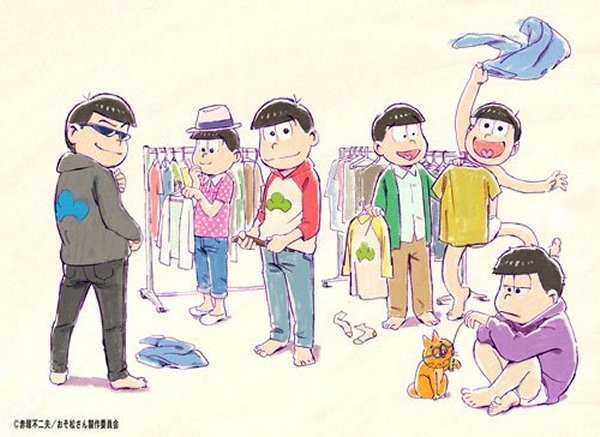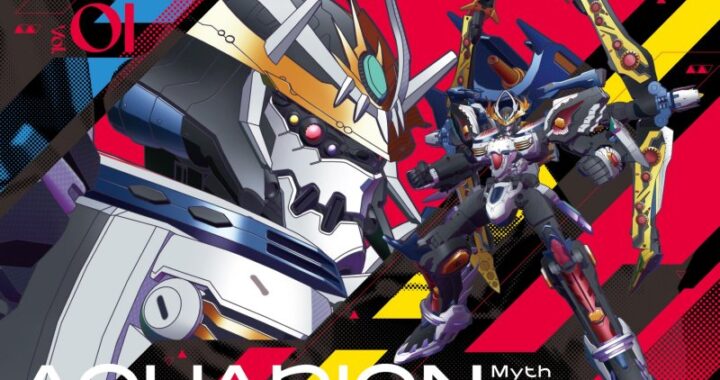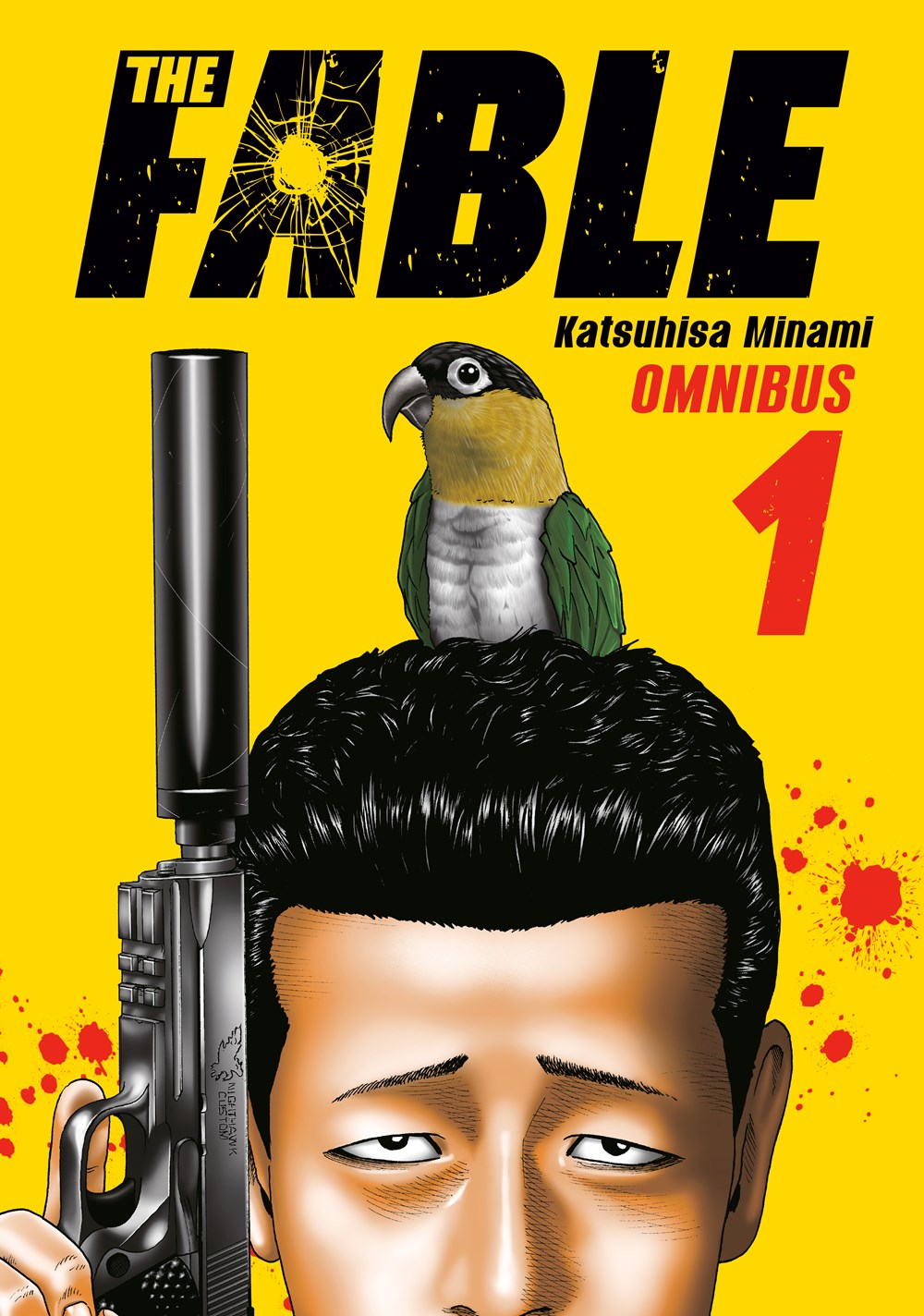 Even for a pro, living a normal life will be The Fable’s toughest mission yet!
Even for a pro, living a normal life will be The Fable’s toughest mission yet!
Creative Staff
Story & Art: Katsuhisa Minami
Original Translation: Adam Hirsch
Lettering: Arbash Mughal
Cover Design: Abigail Blackman
What They Say:
A legendary hitman, known to many as “The Fable”, is the most feared man in Japan’s underworld. After a hot streak of hits, his boss orders him to lie low in Osaka for a year and live a normal life. But for an eccentric assassin like The Fable, his civilian life will be anything but normal.
Content: (please note that content portions of a review may contain spoilers)
You may have heard about him in passing… uneasy whispers of a grim reaper who can kill all his targets with a single shot. I heard he’s killed 100- no, 200 people! Rumor has it he took down an entire yakuza HQ by himself in two minutes flat. Like “The Bell and the Cat” or “The Gnat and the Bull”, the hitman known as “The Fable” poses a moral quandary for Japan’s criminal organizations – if you act up and get on someone’s bad side, you just might find yourself on the other side of The Fable’s crosshair.
Upon reading the first chapter, those rumors just might be true. We’re dropped into the middle of what seems like a horror movie. A few armed thugs are frantically trying to escape – but from what? That’s when we get our first glimpse at The Fable. His design is simple – clad in a black ski mask and matching tracksuit. But it’s that simplicity that spawns unimaginable terror, as the dark specter creeps ever closer, taking out his targets one by one. The final goon, on death’s door, mutters his final words, “So you’re Fable, huh?”
The assassin cocks his pistol and delivers a reality check of a response,
“You people decided to start calling me that. I’m just a guy who’s got a knack for killing… a pro!”
*bang*
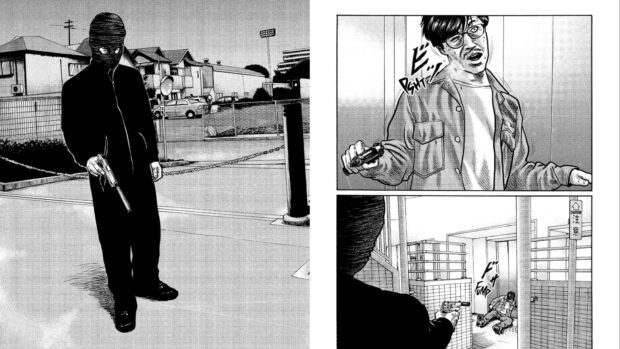
While that cold open presents the manga as a brutal, action-forward thriller, the tone shifts rather quickly. Fable’s boss informs him they won’t be taking on any jobs for a while. Stories of Fable’s accomplishments have spread like wildfire over the past year, and for someone who works in the shadows, being in the spotlight is less than ideal. So, Fable’s boss gives him a new assignment – lie low and live a normal life. Fable and his driver are given new aliases and sent to live in Osaka. As Akira and Yoko Sato, they’ll live under supervision of the Maguro group, a yakuza organization that owe Fable for a previous job. Fable is only given one condition while lying low in Osaka – no killing. While that seems like an easy enough ask, for a trained killer like Fable living under the watchful and weary eye of the yakuza, that may be easier said than done.
This may come as a surprise, but it may be more accurate to label The Fable as a slice-of-life over any other genre. Life in the fabricated town of Taihei, Osaka moves much slower than the hustle and bustle of Tokyo. Sure, we see glimpses of Fable’s hitman prowess, but for the most part, this manga aims to explore its characters rather than some over-the-top story. In the Foreword of Volume One, author Katsuhisa Minami states,
“My mission is to draw characters who seem so real, it’s like they would bleed if you stuck them with a needle. I want to write the kind of manga that experiences the story and grows together with the readers.”
Minami’s attention to characterization is fully realized with our protagonist, Fable. Hitmen in most media have predetermined traits that allow them to be cold-blooded killers. Often, these contract killers are faceless and emotionless, such as Agent 47 from The Hitman videogame franchise. Sometimes these characters are given a bit of nuance, usually spurred by a tragic backstory, such as Leon from Leon: The Professional. But between your Jason Bournes and your John Wicks, there’s always an overlapping trait – these guys are damned good at their jobs. Fable is no different.
But in terms of his characterization, Minami’s approach is less Chad Stahelski and more Seijun Suzuki. Much like Branded to Kill’s Goro Hanada, Fable is an eccentric everyman, with his own quirks, curiosities, and flaws, unlike the legends that precede his reputation. He gets a kick out of third-rate comedians, he walks around his house completely naked, and he has a goofy ritual when going into and out of kill mode. The calculated killer from the first chapter is skewed in a new light – Minami paints his titular hitman as just some weird guy. It just so happens this weirdo is also really skilled at killing people.
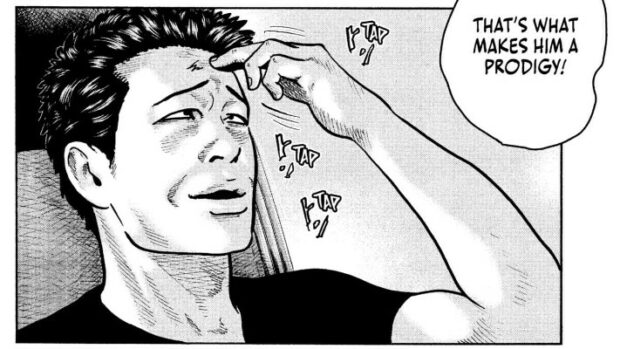
Fable isn’t the only one Minami takes care to establish. We also have his partner in crime, Yoko, a much more level-headed person who tries to keep Fable’s unusual tendencies in check. While undercover, Yoko plans on taking full advantage of her normal life, hoping to snag a boyfriend and enjoy the lax pace Osaka life has to offer. The other mainstays so far include several members of the Maguro yakuza, namely the second in command, Takeshi Ebihara, and his subordinate Takahashi. Ebihara stands as the greatest opposition to Fable’s peaceful life in Taihei. While his boss seems to be repaying a favor to Fable by sheltering him, it doesn’t sit right with Ebihara to allow a shark to freely swim around in their territory. But that bullheadedness may come back to bite him.
As Minami mentions in the Foreword, the story is evolving naturally based on the characters’ emotions and motives, rather than some overarching narrative throughline. The Fable sets that up beautifully with Ebihara and Takahashi. Organized crime isn’t often undone by law enforcement or rival gangs. Most of the time, it’s an internal struggle or crime of passion that causes the house of cards to collapse. Against the boss’s wishes, Ebihara intends to drive the Sato siblings out of his turf. He assigns Takahashi to keep an eye on Yoko, while Ebihara plans on dealing with Fable himself. Their methods are different, but both have the potential to sabotage their underground operations. The boneheaded Takahashi offers a comedic relief escapade, sending local thugs to roughen up Fable while he tries to smooth talk Yoko (both attempts failing hilariously).
It’s Ebihara’s confrontation with Fable that gives the series some philosophical stakes. Not only does Ebihara put Fable in a situation that may compromise his no-kill condition, but he also demands answers from “The Fable”, more so questioning the legend rather than the man standing before him. It’s an excellently crafted character drama, using the fantastical lives of hitmen and yakuza to dig deep into a more profound and visceral view of what life means to these people. And through Fable, Minami establishes that there is no grand scheme to life, no predestined or deliberate meaning to anything. Not in a nihilistic sense, but something captured by the everyday and ordinary.
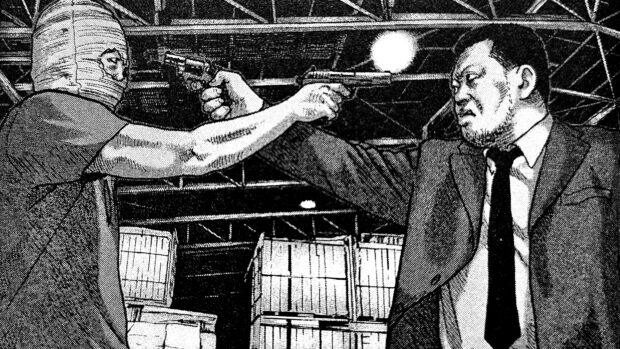
The art feels right at home with The Fable’s grounded story. Rather than the sharp edges and exaggerated eyes of your typical manga, Minami goes for realistic proportions, especially through the distinct features and structures of faces. The action also feels weighty and kinetic, with simple speed lines and blurring to convey movement. Overall, the art is impressive, taking especially good care for certain details like gun design and character expressions.
I feel like The Fable has the potential to do well in North America. Although the series and author are unknown here, it’s the kind of story that Western audiences could really get behind. And with an anime debuting at the same time as the manga here in the States, there’s no better time to get into the series.
The Fable by Katsuhisa Minami arrives in April from Kodansha, the first physical release of the series in North America. This omnibus paperback contains the first two volumes, clocking in at just over 400 pages. The cover comes in a striking yellow, accented by some blood splatters and a bullet hole through the title. It features a headshot of the titular Fable, accompanied by his trademark Nighthawk Custom pistol and his pet parrot, Captain. The back side features the Sato siblings and a crinkled “to-do list” that succinctly depicts Fable’s peculiar personality.
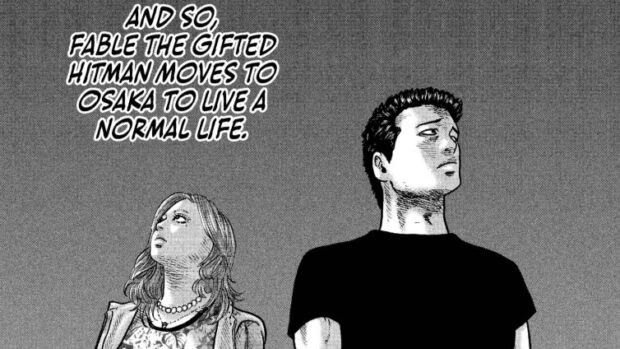
In Summary:
The Fable offers a fresh take on a long-established formula – deconstructing the typical hitman story with slice-of-life elements, comedic flairs, and a metaphysical backbone. Misleading in its simplicity, The Fable will lull you into a false sense of security before pulling the rug out from under you; just as likely to make you bust a gut laughing as it will get you to ponder the bigger picture.
Content Grade: A
Art Grade: B+
Packaging Grade: B+
Text/Translation Grade: A
Age Rating: 18+
Released By: Kodansha
Release Date: April 9th, 2024
MSRP: $22.99 (US)

